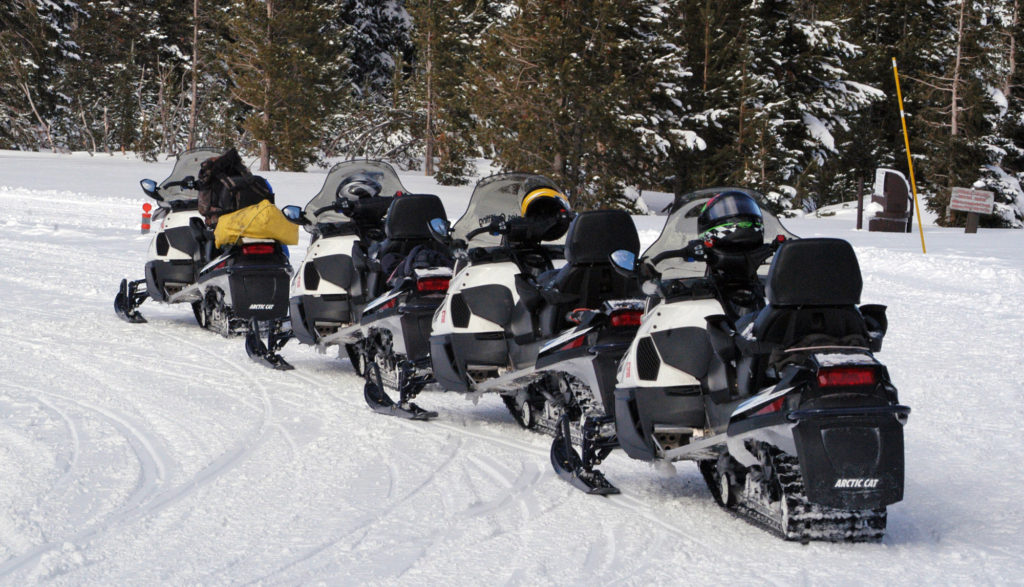
By Ruffin Prevost
CODY, Wyo. — As planners move forward with crafting a new winter-use plan for Yellowstone National Park, they’ll be gauging public response to the idea of so-called “sound events,” one of the few new ideas in a decade of debate and court challenges over managing winter vehicle traffic in the park.
Under two of the potential winter-use alternatives proposed by the Park Service in February, snowmobile and snow coach travel through Yellowstone would be managed by sound events — the total number of noise-producing trips made each day.
“In a way, calling it a ‘sound event’ is a bit of a misnomer, because you’re really measuring impact by event,” said Wade Vagias, the management assistant for Yellowstone Park who is leading the winter-use planning effort.
“It’s a different way of thinking about it, and the public may absolutely hate it, or they may not,” Vagias said.

The Park Service is operating this winter in Yellowstone under a “one-year rule,” designating winter from Dec. 15, 2011 to mid-March 2012 as a “transition year.” That means use levels and restrictions on snowmobiles and snow coaches, for instance, have been the same as the interim rule that has governed use over the past two seasons.
Efforts to nail down a long-term winter-use plan have been complicated by public debate, including court challenges, over issues like snowmobile traffic and avalanche management on Sylvan Pass, between Cody, Wyo. and Fishing Bridge.
The Park Service is seeking additional public comment on specific issues identified in its environmental studies, with a goal of producing a long-term winter-use plan for the 2012-13 season.
Planners will spend the next few weeks reviewing public comments made through March 9 as part of the scoping process for creating a supplemental Environmental Impact Statement. Even before the scoping comment deadline, more than 65,000 comments had been filed on the broad range of potential proposed alternatives, Vagias said.
The two sound event alternatives outlined in scoping documents would allow businesses flexibility in the mix of snowmobiles or snow coaches allowed into the park, while capping the total number of sound events at 100-120 per day. A sound event would be measured as a single snow coach or a group of up to about seven snowmobile riders.
Market approach
Under what the Park Service calls a “market approach” in one alternative, operators would be required to offer both snowmobile and snow coach tours, letting the public ultimately decide the mix of vehicles in the park by their purchasing decisions. (Currently only guided commercial tour operators may bring visitors into the park.)
Sound event management would reduce overall noise, while also creating practical limits for emissions and stresses on wildlife, Vagias said. It would also give tour operators and visitors more flexibility to choose vehicles and set group sizes and schedules. He said such a management model could result in less noise in the park while potentially allowing more visitors through each day.
The market approach is set up to reward innovation and technological improvements, particularly in designing and adopting quieter snowmobiles and snow coaches, Vagias said.
But it’s also aimed at diffusing the seemingly intractable debate over the specific numbers of snowmobiles and snow coaches to be allowed in the park.
At least a half-dozen different sets of winter-use planning documents dating back more than 10 years have all proposed specific fixed daily limits on a combination of vehicles, such as 318 snowmobiles and 78 snow coaches. None has resulted in a lasting management plan, as local governments and interest groups have inevitably sued to block the plans because they allow either too many or too few vehicles in the park.
‘The Box’
Each successive legal challenge and ruling by the courts — along with existing regulations, scientific findings and visitor expectations — further limits the options available to planners for creating a workable winter-use plan, especially when any new proposal is almost certain to draw another round of litigation.
“We refer to it as ‘the box,'” Vagias said, explaining that sound event management is one possible way to operate inside that box of ever-tightening planning restrictions while adopting a fresh approach.
Early responses to the concept have been mixed.
Gary Fales, whose Gary Fales Outfitting is the only company holding a permit to offer snowmobile tours through Yellowstone’s east entrance, said the idea made sense to him.
“I like it better than the other stuff I’ve heard,” Fales said. “It’s a way to let the markets decide.”
Mark Pearson, conservation program director for the Greater Yellowstone Coalition, said he was concerned that “the Park Service is sort of turning over its stewardship responsibility to the marketplace or to tour operators.”
Pearson’s group supports snow coach travel for winter visitors, but favors phasing out snowmobiles completely.
Park researchers have conducted field studies on winter soundscapes in Yellowstone and looked at how visitors perceive vehicle noise, Vagias said. As part of the planning process, the Park Service evaluates the intensity, duration, location and timing of vehicle noise, and incorporates that data as part of the benchmarks used in its management goals.
Most park visitors can’t distinguish the distant sound of a snow coach engine from a group of 7-10 snowmobiles, Vagias said, and the emissions profile and impact to wildlife are also roughly similar between a snow coach and group of snowmobiles.
“If you’re standing in the woods and a tree falls, we all agree it makes a noise, but do you care if it’s an oak tree or a pine tree?” he said.
If noise from an over-snow vehicle disturbs park visitors who value silence and solitude, it shouldn’t matter what machine made the noise, so much as minimizing the noise and managing the effects of the machine on air quality and wildlife, Vagias said.
“What we’re trying to do now is get out of that values position of ascribing numbers to a specific method of travel and get ourselves to the most legally defensible position we can,” he said.
A draft supplemental EIS — which may or may not include proposed alternatives based on sound events — is expected to be released for public review and comment in late spring.
For more information on winter-use planning in Yellowstone National Park, visit the National Park Service web site.
Contact Ruffin Prevost at 307-213-9818 or [email protected].

Indulge me while I mix my metaphors. The new player at the YNP Winter Games table, Sound Event, is appears behind the smoke and mirror of a song and dance as we rush to end the game. After all , the special rule that kept Yellwostone open at all these past seasons is due to sunset this year, yet we have a whole new topical tangent to resolve in the few remaining months. It was not made clear at the Cody meeting on the latest plan episode just where and by whom this ” Sound Event” scenario was gestated after all these years without hearing anything like it ( pun intended). I have my suspicions, but they are just that.
My two questions. First, the Park Service when asked stated they had no idea how theyw ere going to actually measure decibel levels or even what the benchmark for those decibels would be. Measuring decibels in the wild is more art than science, whether in the winter woods or on a city street trying to enforce a Noise Ordinance. What equipment, training, and criteria are to be used and does it allow for the many variables, not the least of which is the effect of temperature on transducement of sound waves thru a fluid dynamic ( atmosphere).
More importantly , why should we not also apply said Sound Event operational philosophy to the many tens of thousands of Harley Davidsons and diesel tourbuses that rumble thru Yellowstone in July and August , disrupting the auditory environment mightily and theoretically disturbing the wildlife that have migrated back into the Park from winter homes and seem to cluster near asphalt.
In other words, why should Solitude take supreme precedence in winter but is nowhere to be found in summer , when 3 million people in 600,000 vehicles gird and gridlock the Park ?
Dewey,
Before you posted this comment, I had been working to finish up a companion piece that addresses (but may not answer) your questions about sound in winter vs. summer. Click on the “related story” link now included in this story, or on the link below:
-Ruffin
http://www.yellowstonegate.com/2012/03/debate-over-yellowstone-park-winter-use-dates-back-more-than-50-years/
More hogwash ~
Dewey, snowmobiles are soft targets for the tree huggers, it would be nice to see them pick a fight with 20 million bikers though :D